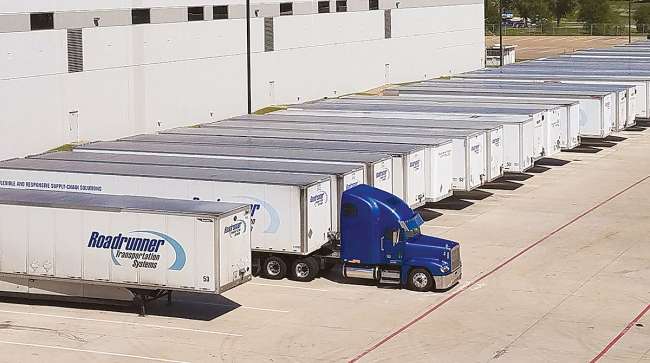Growth Continues, but Risk of Recession Looms Larger, Economist Says

ORLANDO, Fla. — Freight brokerage and third-party logistics firms can expect another year of positive business growth before facing an increased threat of recession, according to economist Noel Perry.
The probability of an economic downturn in 2020 is at least 40% due to a falloff in auto sales, an increase in unsold inventory and weakness in government spending, Perry said at the Transportation Intermediaries Association Capital Ideas Conference & Exhibition here on April 13.
He serves as chief economist for load board operator Truckstop.com and provides research and consulting services to transportation-oriented clients.
Thank you everyone for coming to #TIA2019Con and making it a huge success! See you next year at #TIA2020Con in Austin! pic.twitter.com/Wh11nD52HM
— TIA (@3PLAssociation) April 14, 2019
The length of the current recovery is already the longest in the post-World War II period, Perry said, and may have been prolonged by the Tax Cut and Jobs Act, which provided a boost to business investment and consumer spending in 2018.

Perry
Going forward, the growth of industries that are “truckload intense,” such as manufacturing, are likely to weaken, Perry said, making it harder to maintain positive growth in gross domestic product. A recession is defined as two consecutive quarters of negative GDP growth.
“Recessions can be very nasty,” Perry said, “especially for spot markets.”
The spot market is where freight brokerage firms match up available loads with freight carriers and is considered more volatile than the contract market in which shippers strike long-term deals with freight carriers.
A mild recession, Perry said, would likely feature a 10% decline in load volume, a slightly smaller drop in prices and a significant loss of revenue for freight brokerage firms. A recession like the one in 2008-09 would produce a drop of more than 25% in load volume, a double-digit percentage drop in prices and revenue losses of more than 40%, Perry said.
“Fleets should be putting away money and solidifying relationships with shippers,” Perry advised. “Long-term contracts are preferred.”
Signs of a slowdown are beginning to appear.
Bob Costello, chief economist for American Trucking Associations, said data released so far “suggests that the economy grew, but moderated, in the first quarter, as expected.”

Costello
Gains in manufacturing employment, in particular, slowed to a crawl and employment in trucking fell by 1,200 in March, the first monthly drop since last April. Retail sales declined 0.2% in February after rising 0.7% the prior month. And the ratio of inventory to sales rose in January to its highest level since August 2017.
“I’m growing increasingly concerned that there’s a glut of inventories throughout the supply chain that will, and probably already has, hurt truck freight volumes,” Costello said in a recent report on the economy.
The Cass Truckload Linehaul Index, which tracks what shippers pay in both contract and spot markets, was 139.9 in March, an increase of 4.8% from the same month a year ago, but is trending down.
“We expect continued increases in coming months, but at slightly lower percentage increases,” said Donald Broughton, an industry analyst and contributor to indexes produced by Cass Information Systems, a financial services firm based in St. Louis that handles $60 billion in freight payments annually.
“We are lowering our realized pricing forecast for 2019 from between 2% and 5% to between 1% and 3%,” Broughton said.

Misheloff
Rob Misheloff, president of Smarter Finance USA, a Las Vegas-based loan brokerage firm, said he sees signs that lenders are pulling back from financing trucks and small fleets in response to a rising number of loan defaults.
“Since 2015, it kept getting easier to fund trucking deals,” Misheloff said in an interview with Transport Topics, “but over the past 12 to 15 weeks, lenders have been tightening up because they are not seeing the performance and this may be an indicator of the direction of the economy. It’s not yet like 2008, but it could become like that.”
While the booming economy in recent years has kept default rates on trucking loans fairly low, Misheloff said he anticipates the percentage of troubled loans to increase to between 15% and 20% for borrowers with less than stellar credit.
As a consequence, according to Misheloff, some lenders have exited the market completely, while others have restricted lending to larger fleets or are limiting loans to trucks that are less than 5 years old or have no more than 500,000 miles.
Misheloff said two of his funding sources have said they are no longer providing loans to trucking startups.
FTR Intelligence, a Bloomington, Ind.-based research firm that tracks changes in freight volume, rates, capacity, fuel price and financing, said its trucking conditions index fell sharply from December to January and is expected to moderate further toward neutral territory through at least the third quarter of 2019.
The environment for shippers, as measured by changes in freight demand, rates, fleet capacity and fuel price, is close to neutral through the first quarter and is expected to rise slowly as the year progresses, FTR reported.



